- Home
- Listings
- Things To See & Do
- Car Hire
- News
- Properties
- What’s On
ES
Movies Filmed in Granada
How Granada became a top movie location
Nestled in the heart of the picturesque region of Andalusia, the province of Granada stands as a cinematic stage in itself, where the grandeur of its historical and natural landscape has served as the backdrop for numerous film productions over the years. From the towering peaks of Sierra Nevada to the intricate alleys of the Albaicín and the Palaces of Alhambra, every corner of this land breathes a rich cultural heritage that has captured the attention of world-renowned filmmakers. In this article, we will delve into the fascinating world of movies shot in the province of Granada, exploring how this unique enclave has been shaped by the magic of cinema, becoming a character in its own right in stories that have left an indelible mark on the big screen.
In the 1960s, Hollywood experienced a prolific era of film productions, and during this time, Guadix and its surroundings became a preferred setting for directors and producers. The region offered a variety of ideal landscapes and boasted a railway line, which proved very convenient for both Western films and the logistical needs of the production team.
In recent years, Granada has continued to be a prime location for notable productions, such as the filming of Netflix’s “Black Mirror” in the desert of Gorafe and the movie “Society of Snow” by J.A Bayone and produced by Netflix based on the Andes planes crash which was shot in Sierra Nevada in 2022.
Let’s embark on a journey through the history of these remarkable film shoots, where we can visit these locations throughout the province of Granada.
Top international movies shot in Granada
La Sociedad de la Nieve (Society of the Snow): Sierra Nevada, Witness to the Andes Miracle
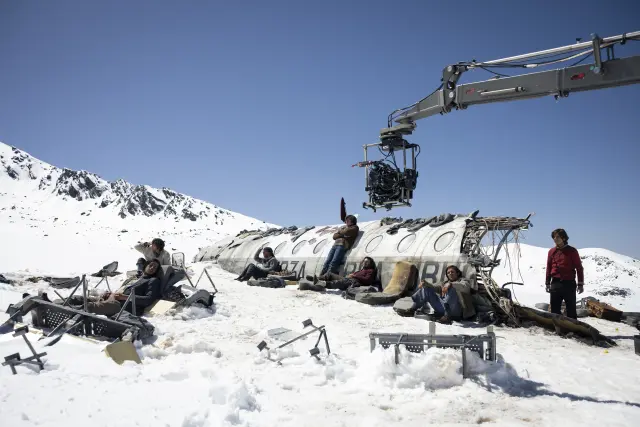
The Netflix production that is sweeping through views, festivals, and international awards tells the real story of the tragic crash of the Uruguayan Air Force plane in the Andes on October 13, 1972. Of the 45 passengers, only 16 survived after being stranded for 72 days in a snowy hell. We delve into the filming under harsh conditions that the director of the movie J. A. Bayona and the actors portraying the rugby team, including Enzo Vogrincic and Agustín Pardella, experienced in the mountains of Granada.
While in 1993, for “Alive!”, Frank Marshall chose British Columbia in Canada, Juan Antonio Bayona sought maximum realism and preferred Sierra Nevada for “La Sociedad de la Nieve” (Society of the Snow). Here, he found the perfect conditions and more hours of daylight.
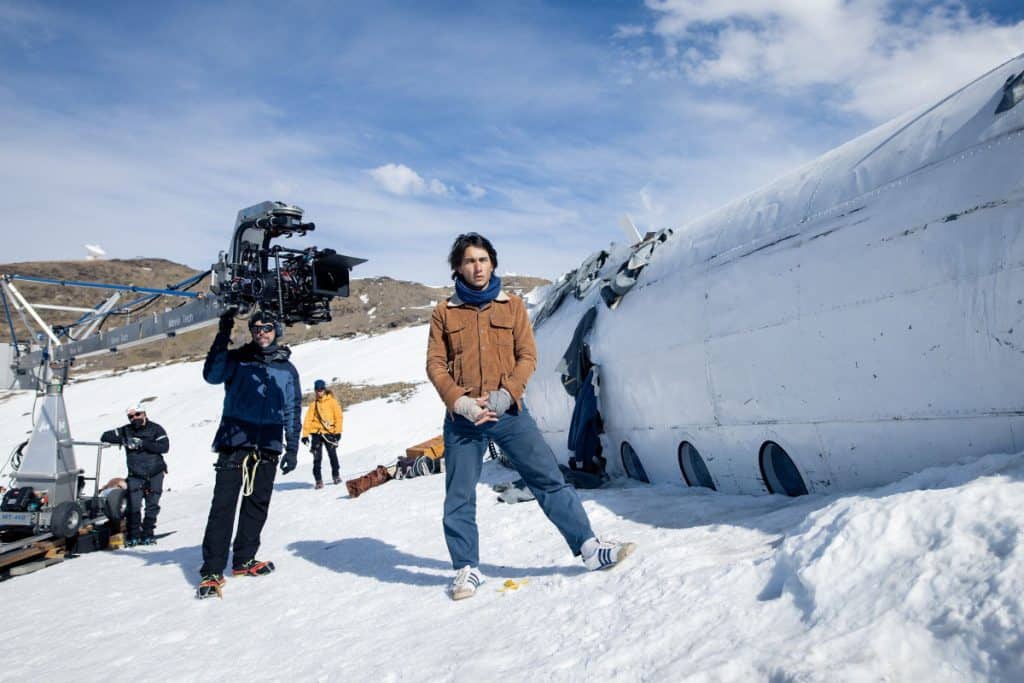
In 2021, Juan Antonio Bayona got in touch with Cetursa Sierra Nevada and the Sierra Nevada National Park to explore locations. Pradollano, Hoya de la Mora, Cortijo La Argumosa, and Laguna de las Yeguas were the selected settings.
After two months of pre-shooting in the Andes in August 2021, where extensive shots and mountainous landscapes were captured under various lighting conditions throughout the day, the team moved to Sierra Nevada in January 2022 for a 5-month shoot. During this time, they even faced the Saharan dust storm that brought mud rains across the province of Granada and turned the snow in Sierra Nevada orange.
The base camp was set up in the Los Peñones parking area, at the top of the Pradollano station, at an altitude of over 2000 meters. There, the team built a hangar and one of the three recreations of the Fairchild FH-227D, the crashed plane, with great accuracy to convey the claustrophobia experienced by the survivors. A 12-meter LED screen was installed, projecting all the photographic and topographic material collected during their expedition to the Andes.
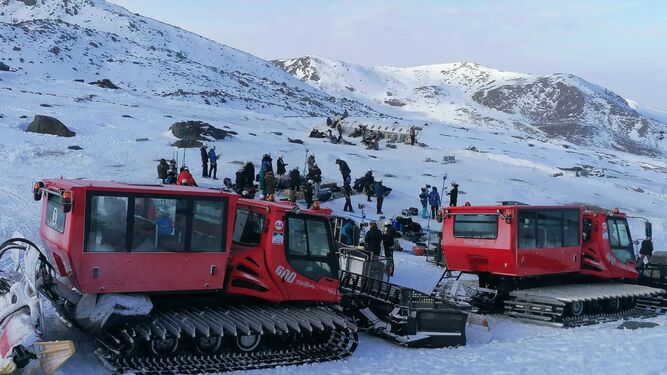
The second main location was Laguna de las Yeguas, at almost 3000 meters above sea level, where a second recreation of the plane was installed, and many outdoor scenes were filmed. It is one of the scenarios most frequently seen in the film. Every day, about 100 people were transported in groups from the station’s hotels to Laguna de las Yeguas in a snow-adapted tank vehicle. Here, they faced weather challenges that slowed down the project. The biggest technical challenge was the transfer of the plane from the Hoya de la Mora parking area to Laguna de las Yeguas. Consulting with Sierra Nevada machine operators, it was decided to use two bulldozers, one pulling and the other pushing, to move the 14-meter, seven-ton model. The transfer took place late in the afternoon when the snow was firmer, and the risk of sinking was lower.
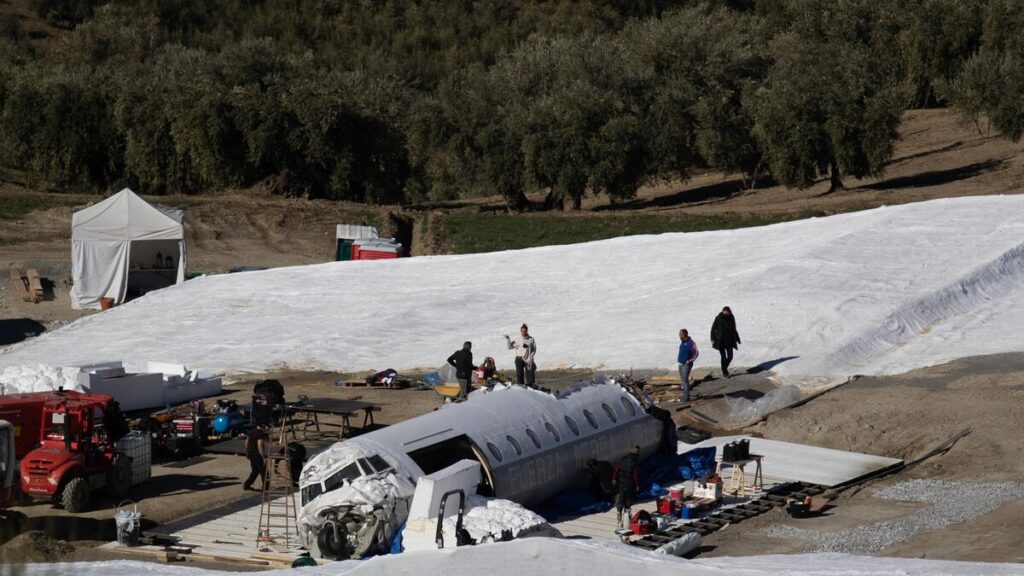
The third location, Cortijo de La Argumosa, in Güejar, at a lower altitude, served as the production area where scenes that couldn’t be captured outdoors were filmed, including the famous avalanche that buried the survivors of the crash, causing the death of eight of them. On this set, a platform was built that allowed the upward and downward movement of the fuselage.
Memories of the Alhambra
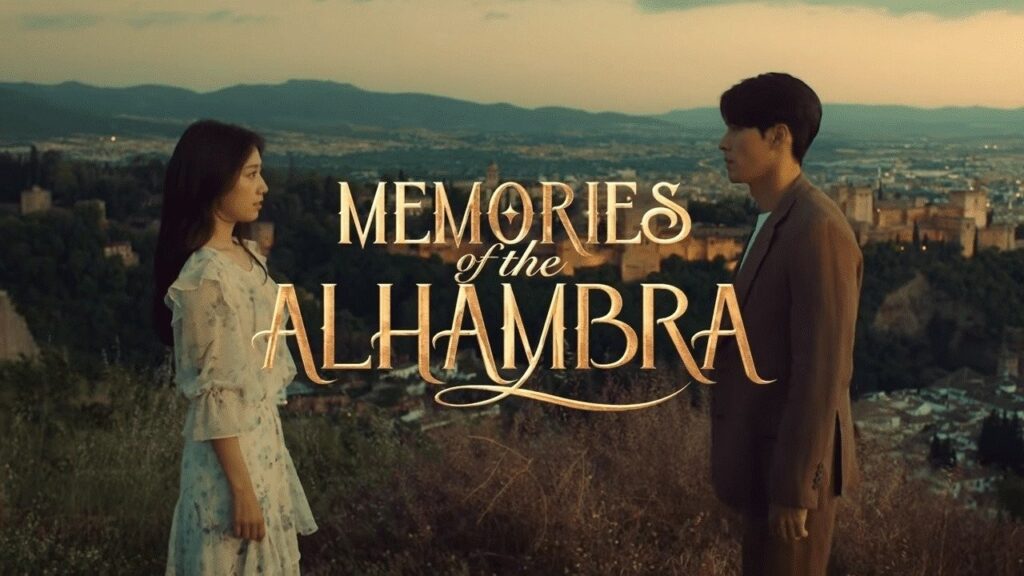
Memories of the Alhambra, a groundbreaking Netflix series shot against the stunning backdrops of Granada, played a pivotal role in elevating Granada’s profile among audiences in Korea and the Far East. This captivating series not only showcased the beauty of these Spanish locales but also significantly contributed to putting Granada on the cultural map for viewers in distant corners of the world.
The series features Korean actors Park Shin-Hye and Hyun Bin in a captivating Korean Drama. This fantasy-mystery series revolves around CEO Yoo Jin Woo, who receives a mysterious call from game creator Jung Seju, drawing him into a new Augmented Reality (AR) Game. Jin Woo travels to Granada to test the game, staying at a hostel owned by Seju’s family. As the boundaries between AR and reality blur, Jin Woo and Heeju find themselves entangled in a dangerous series of events, embarking on a quest to locate the missing game creator, Jung Seju.

The drama’s technical aspects deserve acclaim for their excellence. The innovative use of contact lenses, immersive gameplay, and the seamless integration of AR into Ji-Woo’s perspective lent a lifelike quality to the game. The cinematography is particularly striking, with the drama being filmed on the streets of Granada in Spain. The well-executed camera shots contribute to the overall beauty of the series, showcasing the superb graphics and cinematography of Memories of the Alhambra.
Assassin's Creed (2016)

Many of the outdoor scenes in the 2016 movie, Assassin’s Creed, starring Michael Fassbender, Marion Cotillard, Jeremy Irons, were filmed in Castillo de La Calahorra, Granada province. The Alhambra also appears in the scene where Aguilar de Nerha finally gets to join the Assassin Brotherhood. In the story, Cal Lynch (played by Fassbender) embarks on a journey through time to 15th-century Spain using groundbreaking technology that taps into the genetic memories embedded in his DNA. Transported to the past, he assumes the life of Aguilar de Nerha, a distant ancestor and a member of the Assassins, an undercover society dedicated to defending free will against the ambitious Templar Order. As Cal relives Aguilar’s experiences, he undergoes a profound transformation, acquiring the knowledge and physical prowess needed to confront the oppressive Templar Order in the contemporary world.
This ambitious adaptation has been directed by the Australian filmmaker Justin Kurzel, who made a special effort to shoot outdoors as much as possible and to use practical effects instead of creating virtual elements through computer-generated imagery. The film, based on the famous Ubisoft franchise, is not based on any particular video game. Both the plot and its characters are entirely original.
The Alhambra had previously served as a setting within the video game itself, but this marks the first time it will hit the big screen within this franchise.
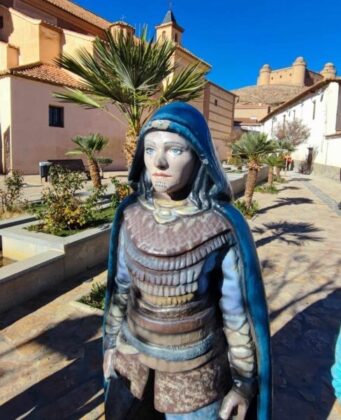
In the streets of La Calahorra, one can find some additional inhabitants among its streets. These are a series of statues resembling a “Hall of Fame” featuring Marion Cotillard, Sean Connery, Clint Eastwood, and the Iron Throne from the renowned “Game of Thrones” saga as a tribute to the cinematic tradition of the municipality.
From Loja to Freedonia: The Unlikely Connection in "Duck Soup" (1933)
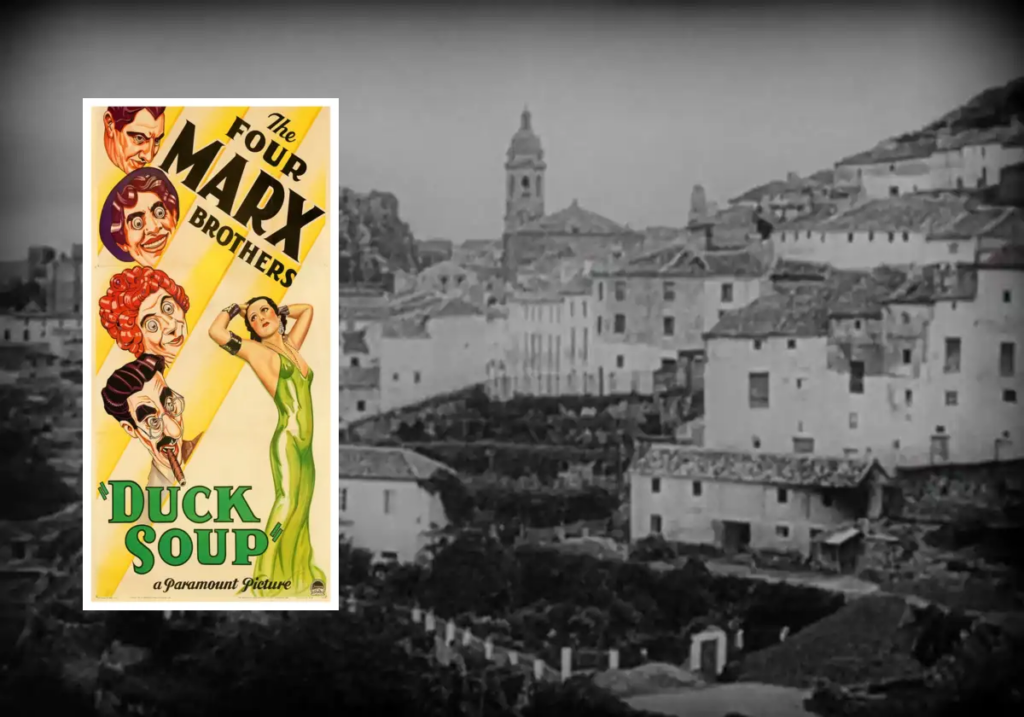
In the realm of classic cinema, few names resonate as humorously and timelessly as the Marx Brothers. Among their comedic masterpieces stands “Duck Soup” (1933), a film directed by Leo McCarey and featuring the iconic Groucho, Harpo, Chico, and Zeppo Marx, along with Margaret Dumont and Mexican actress Raquel Torres.
While the plot of “Duck Soup” transports viewers to the fictional Republic of Freedonia, a small Central European country led by the eccentric Rufus T. Firefly, what’s even more intriguing is the real-world backdrop used to depict the rival nation of Sylvania. Surprisingly, the scenes representing Sylvania were filmed not in some far-off European location, but in the charming town of Loja, just 45 minutes away from Granada’s capital.
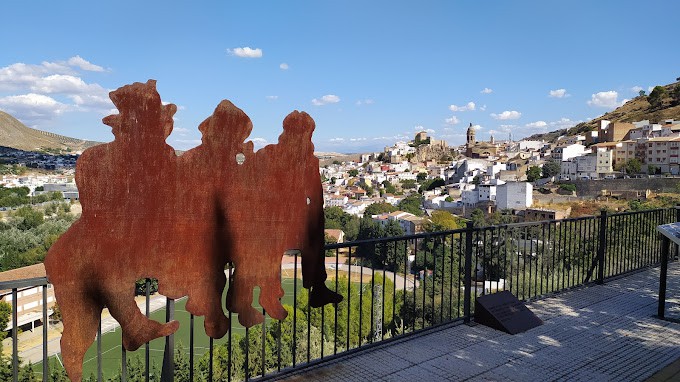
Loja’s Mirador de Sylvania, situated in the Mesón Arroyo neighborhood, played a pivotal role in the film. This view point, showcasing the Church of the Incarnation and the Alcaides Cristianos Mansion adjoining the Tower of Homage in the Loja fortress, became the picturesque setting for the fictitious city of Sylvania.
The film opens with a breathtaking panoramic view from a mirador in Loja, capturing the essence of Sylvania. Even today, almost ninety years later, Loja’s skyline remains remarkably unchanged. Metal figures resembling the unmistakable silhouette of the Marx Brothers stand as a testament at the town, reminding visitors that Loja was once transformed into the cinematic realm of Sylvania.
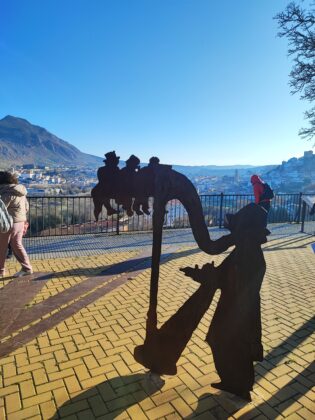
The intriguing question arises: How did Loja become Sylvania? The answer to this mystery is as elusive as the whimsical plot of “Duck Soup.” Some locals proudly speculate that the Marx Brothers stumbled upon Loja during their travels and were captivated by its picturesque scenery. However, the true origin remains shrouded in mystery.
One imaginative local legend suggests a lovelorn Loja native, who had ventured to Los Angeles in search of fortune, met Harpo Marx one fateful night. Harpo offered him a job, and upon returning to Loja as a location scout, the native brought back the photograph that later became Sylvania. Though captivating, this story has been debunked as false.
Another cinematic theory connects the film’s frame to José Val del Omar, a Loja-born photographer and filmmaker who supplied Kodak with Andalusian photographs. Perhaps, during this period, Val del Omar submitted a picture of his hometown to Paramount, and in a twist of fate, the panorama of Loja was chosen to represent Sylvania. However, this theory lacks concrete evidence.
Robert S. Bader, an American expert on the Marx Brothers, acknowledges the uncertainty surrounding the film’s locations, stating that neither the producers nor the stars of “Duck Soup” likely had any knowledge of the stock photos used to depict Sylvania.
In the end, “Duck Soup” stands as a testament to the cinematic magic that turned a quaint town like Loja into a fictional nation on the brink of war. As Loja’s skyline continues to overlook the passing years, it remains a living testament to the unexpected marriage of classic comedy and the enchanting landscapes of Granada.
"Doctor Zhivago" (1965): The Magic of Granada in the Russian Revolution
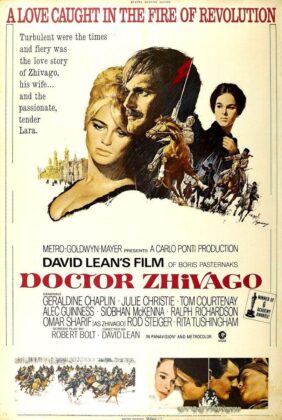
“Doctor Zhivago” (1965), directed by David Lean and based on the novel of the same name by Boris Pasternak, is a classic that immerses audiences in the tumultuous Russian Revolution. Starring Omar Sharif, Julie Christie, and Geraldine Chaplin, the film tells the story of the doctor and poet Zhivago, whose life is disrupted by war and his complex relationships with Tonya and Lara.
Although the plot is set in 1917 Russia, the film couldn’t be shot on Soviet soil due to the ban on Pasternak’s book. The choice of Spain, with its diverse geography and low production costs, became the main location.
The extensive filming, spanning Soria, Salamanca, Madrid, and Granada, lasted almost a year, involving over 3000 extras paid 1500 pesetas per day. Granada, particularly the plains of Marquesado del Zenete near La Calahorra, provided a spectacular backdrop for the scene of Zhivago’s mother’s burial, with Sierra Nevada in the background.
“Doctor Zhivago” triumphed at the box office and received fice Oscar awards. The film is remembered for its exceptional plot and the stunning Granada landscapes that transported the audience to the Siberian steppes.
Indiana Jones and the Last Crusade (1989): The Granada Odyssey
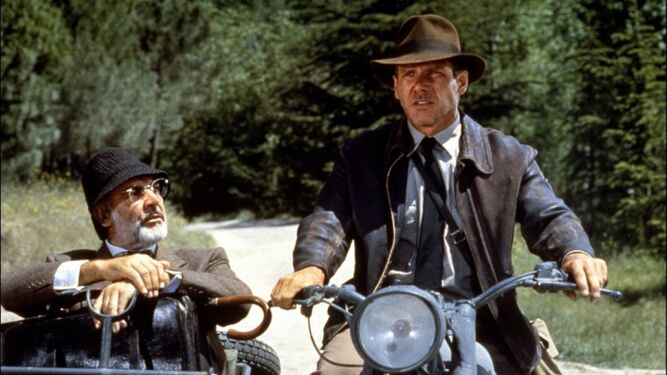
Directed by Steven Spielberg and starring an all-star cast including Harrison Ford, Sean Connery, Alison Doody, Denholm Elliott, John Rhys-Davies, and River Phoenix, “Indiana Jones and the Last Crusade” immerses us in the quest for the Holy Grail. The story unfolds as Indiana’s father, Henry Jones (Sean Connery), is kidnapped by Nazis while on the trail of the sacred relic. Indiana embarks on a mission to rescue him and prevent the Nazis from obtaining the legendary chalice used by Jesus at the Last Supper, as they believe it grants immortality.
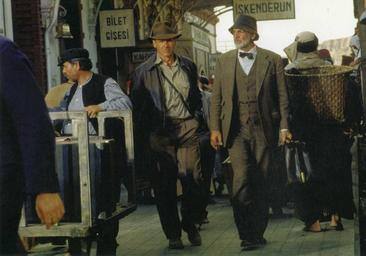
The filming odyssey began in May 1988 in southern Spain, specifically in the Tabernas Desert of Almería, known for its Mini Hollywood and the filming of numerous spaghetti westerns. The thrilling tank chase sequence was filmed there. Additional scenes were captured on the iconic beach of Mosul.
In June, Spielberg and his team moved to the province of Granada, transforming the Guadix train station into the fictional Turkish city of Iskenderun. With a plentiful cast of extras and an exotic atmosphere, around 200 people were hired for these scenes. Keen-eyed spectators have spotted some local residents who inadvertently appeared in the shot without the appropriate period attire.
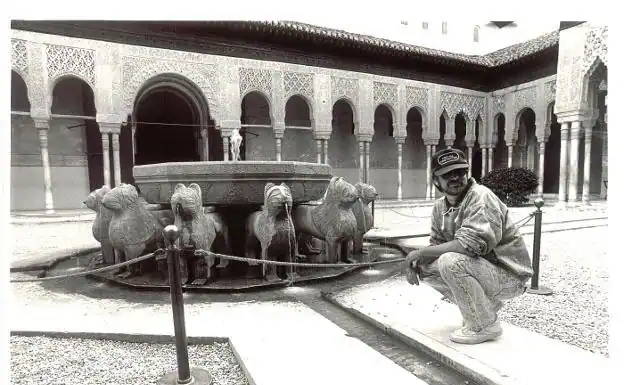
Although Spielberg initially intended to film at the Alhambra, an agreement with the Alhambra Board could not be reached to obtain permits. Spielberg’s original vision included driving a Rolls Royce in the Nasrid Palaces. The Alhambra was ultimately excluded from the script for two practical reasons: the impossibility of interfering with the monument’s high daily visitor traffic and because, being a globally recognized monument, it would be impossible to simulate it as any other location in the world.
Another sequence filmed in Granada was the sidecar scene, featuring Harrison Ford and Sean Connery at a crossroads in an Austrian forest where a sign marks two paths: Venice or Berlin. In reality, this was shot in Natural Park of Sierra de Huétor, near the Prado Negro restaurant. The location is perfectly recognizable and worth enjoying a hiking route through the surroundings.
Black Mirror: The Utah Desert House where we can sleep in Gorafe
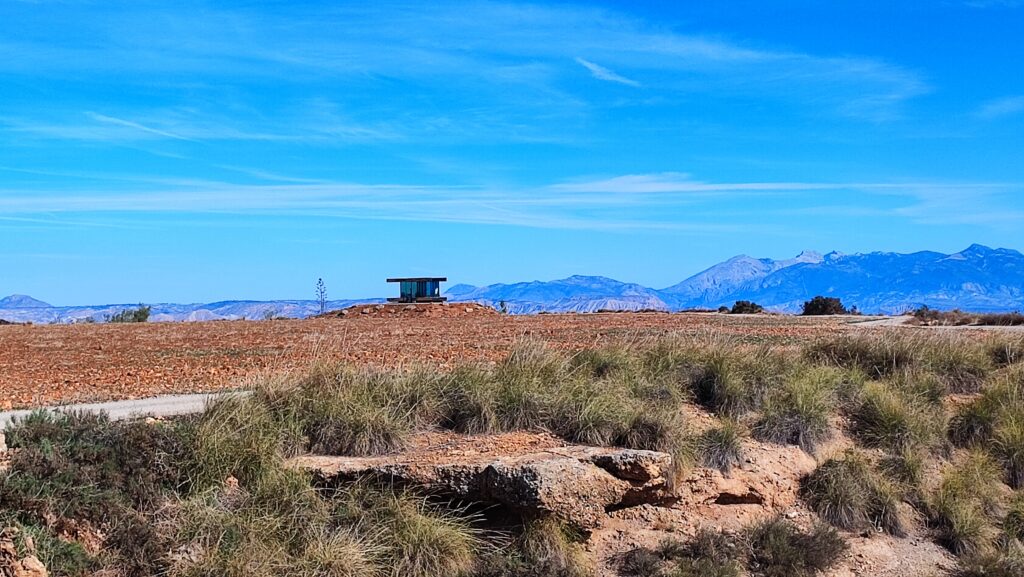
Black Mirror is a successful science fiction series known for portraying an imaginary but not-so-distant future from our reality. In this future, the extreme use of current technologies has almost fatal consequences.
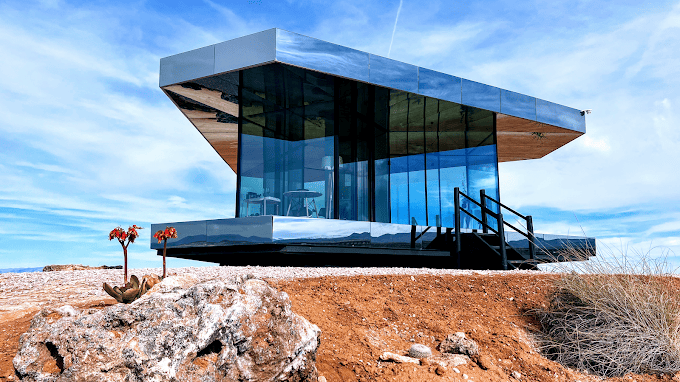
In one of the episodes from the fifth season, created by Charlie Brooker and one of the most-watched series on the Netflix platform, ‘The Desert House’ in Gorafe served as a unique and surprising glass construction. This glass house becomes the perfect setting to escape from the ‘connected’ world in the episode ‘Smithereens,’ starring Topher Grace, the main actor in Spider-Man 3, among other films. The shooting of this episode took place over two full days in the summer of 2018.
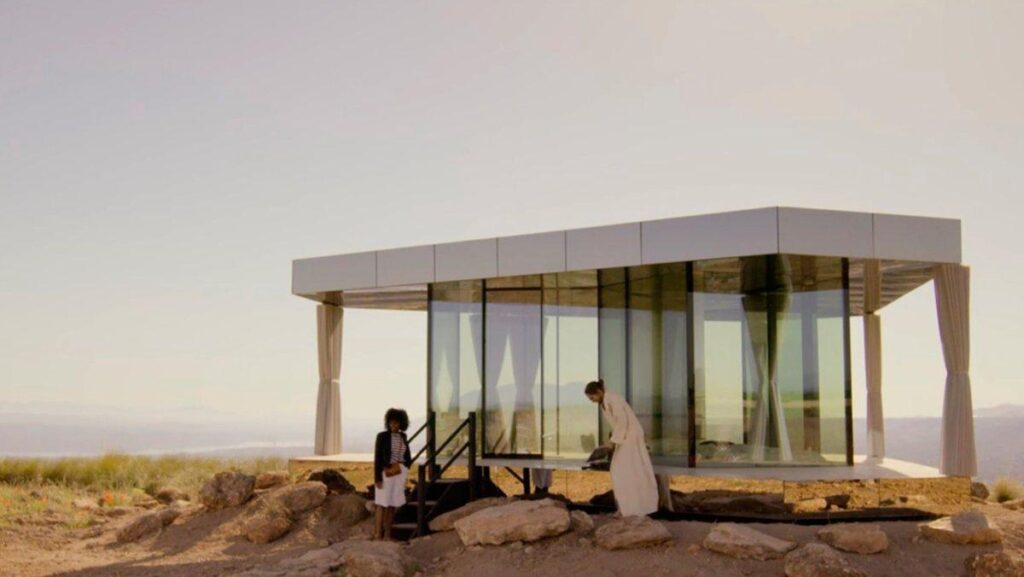
Located in the Geopark of Granada, near Gorafe at the end of the plateau, the house has a strategic location away from civilization. Designed by Spela Videcnik of OFIS Architecture, along with engineers and energy consultants from AKT II and Transsolar, the house is built on a wooden structure, entirely glazed by Guardian Glass. With only 20 square meters, it demonstrates that sustainable living is possible in the desert of Gorafe, one of the most extreme climates in Europe. The house features Guardian Glass walls and is equipped with water filtration systems, energy production, and solar panels. It includes a bedroom, bathroom, and living room. This fully glazed and self-sufficient design can withstand large temperature variations of up to 30º in a single day, thanks to its thermal glass that regulates temperature.

The house, conceived to challenge nature and located in a desert area, can be rented as tourist accommodation from 250 euros per night for two people. It offers a 360º view of the desert and places like the Geopark, Guadix, Baza, Sierra Nevada, Cazorla, and Sierra Mágina. Moreover, it is particularly spectacular to observe the stars at night due to the absence of light pollution in the area. The location is ideal for 4×4 routes, cycling, and hiking.
Filming of "The House of the Dragon" at La Calahorra Castle: Epic Fusion of Fantasy and Reality

The series “Game of Thrones” has left an indelible mark on contemporary television, leading to a new wave of productions that expand the universe of this epic narrative. Among them, “The House of the Dragon” stands out as a prequel that takes us back to the events preceding those of the original series. Spain has become a favored setting for producers, and on this occasion, Granada and its majestic La Calahorra Castle have been chosen to bring to life some of the most iconic scenes.
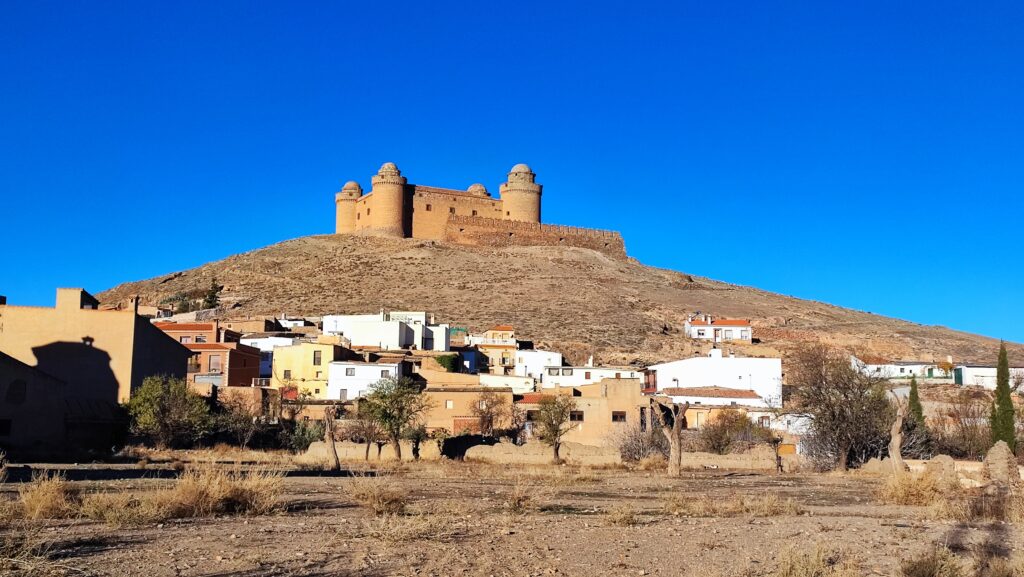
La Calahorra Castle, erected on the only hill at the foot of the Sierra Nevada dominating the vast plain of the Marquesado del Zenete near Guadix, goes beyond its historical significance to serve as an exceptional cinematic witness. This fortress built in the 16th century has previously hosted productions like “The Wind and the Lion” with Sean Connery, “Assassin’s Creed” and “Inés del Alma Mía.” In “The House of the Dragon,” the imposing walls and intricate corners of the castle merge with the epic fantasy of the “Game of Thrones” universe.
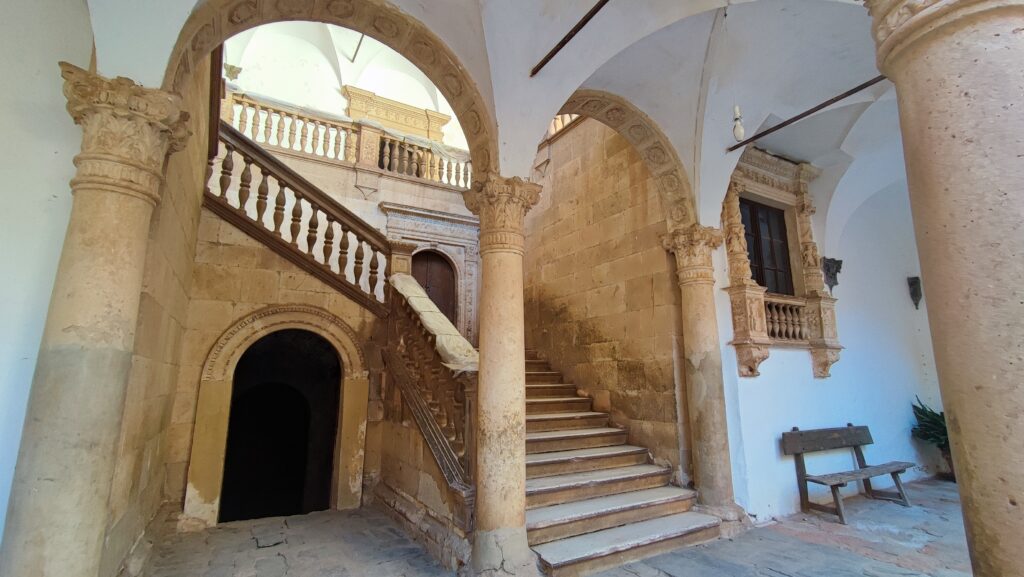
The history of La Calahorra Castle dates back to the 16th century when the Marquess of Zenete, Don Rodrigo Díaz de Vivar y Mendoza, decided to construct a fortress for residence and defense. Construction began in 1509 and extended over several years under the direction of the architect Miguel Fernández. The castle’s architecture reflects the transition from Gothic to Renaissance style. Its sturdy walls and imposing towers bear witness to its original defensive function, while Renaissance elements like the facade and the white marble door add a touch of refinement and elegance.
Today, La Calahorra Castle is privately owned and open to the public by appointment, offering the opportunity to explore its chambers and immerse oneself in its historical legacy. Guided tours allow visitors to delve into the castle’s history, from its origins to the events that marked its walls over the centuries.
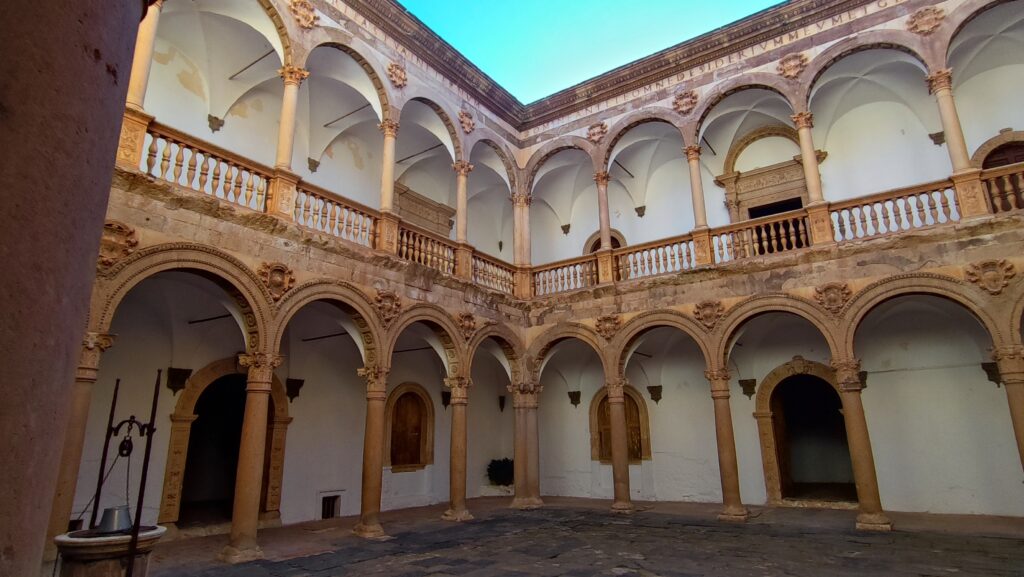
As part of the series production, La Calahorra Castle was transformed into Pentos Castle for the filming of the sixth episode titled “The Princess and the Queen.” A crucial moment in this episode unfolds at the 24th minute, where Daemon Targaryen, riding his dragon, provides a breathtaking view of the Granada castle, using aerial shots capturing the fortress from various perspectives. Another notable setting is the courtyard of La Calahorra Castle, where a dinner scene featuring Daemon, Laena, and their daughters Baela and Rhaena was filmed. The authenticity of the magnificent courtyard, constructed in the 16th century with marble imported from Italy, remains intact, providing an exceptional backdrop for this pivotal scene. The upper area of the castle, converted into a library, and the meeting room transformed into a bedroom, add layers of detail to the narrative of “The House of the Dragon.” The conversation between Daemon and Laena in the towers on the left side, overlooking the town of La Calahorra, adds authenticity to the series and highlights the architectural beauty of the castle.

Filming took place during both day and night sessions, allowing local residents to witness firsthand the magic of a large-budget production. This event not only underscores the unique connection between fantasy and reality but also promotes tourism by showcasing the greatness of La Calahorra Castle. La Calahorra Castle is not only a historically significant monument but has also become a prominent player in the film industry. Its fusion of imposing architecture and participation in renowned productions solidifies its status as an essential destination for those seeking to explore the cultural and cinematic richness of the region.
Why Southern Spain is a Filmmaker's Dream Location
This is only a small selection of movies filmed, or partly filmed, on location in Granada or nearby Almeria. Other blockbuster movies shot in this region include “The Good, the Bad and the Ugly,” “Once Upon a Time in the West”, and in Almería: “Lawrence of Arabia,” “Exodus: Gods and Kings,” and “The NeverEnding Story” . While “2001: A Space Odyssey” was not filmed in Spain, the moonscape scene viewed through the spaceship window is actually from Almeria! Also, Heart Attack’ (2014), a Bollywood movie chose Plaza Nueva, Granada central square to shoot a scene, complete with dancers. The film also explored Bib Rambla and the area near the cathedral.
Some of the top Spanish movies and TV series filmed in Granada include Un día perfecto, Isabel Carlos Rey Emperador, El principe, Días Contados, Canibal, Muerte en Granada, Secaderos, Cerrar los ojos.
Southern Spain has long been a favored destination for filmmakers seeking the perfect backdrop for their cinematic creations. The region’s allure is attributed to a combination of factors that make it an ideal setting for a diverse range of films. One of the primary reasons filmmakers flock to the south of Spain is the reliably good weather. Along the coast, especially on the Costa Tropical, it rarely rains, offering filmmakers an average of 320 days of sunshine each year. This dependable climate provides a consistent and desirable environment for shooting, avoiding the unpredictability that weather fluctuations can introduce to film schedules. The variety of scenery is another important factor. Spain boasts one of the most diverse landscapes globally, earning it the moniker of a “mini continent.” From the lush green vegetation of Lecrin Valley to the Los Coloraos desert, known as the perfect backdrop for Westerns, the tropical coast with its sandy beaches and palm trees, and the snow covered slopes and pine forests of the Sierra Nevada, the variety of landscapes in the south of Spain offers filmmakers an array of settings within a relatively small geographical area. Quality of light is another important consideration in movie production. The quality of light in Spain is renowned as one of the best in the world. This has attracted not only filmmakers but also famous painters who chose to live in the country. The unique and brilliant light enhances the visual appeal of films, adding a distinct and captivating quality to the cinematography. Spain’s reputation as a cost-effective destination is another draw for filmmakers. The affordability of accommodations and services, including feeding and housing film crews, makes it an attractive choice compared to other European destinations. The relatively lower production costs contribute to making the filmmaking process more budget-friendly. The combination of reliable weather, diverse landscapes, exceptional light, snowy options, cost-effectiveness, and political stability establishes the south of Spain as a preferred destination for filmmakers looking to bring their visions to life on the silver screen. Moreover, Spain’s long-established film industry provides filmmakers with a robust infrastructure, encompassing technical expertise, studio resources, and a wealth of experienced professionals, further solidifying its status as a cinematic haven.
Spanish movies filmed in Granada
Intemperie: A Cinematic Journey through the Geopark of Granada
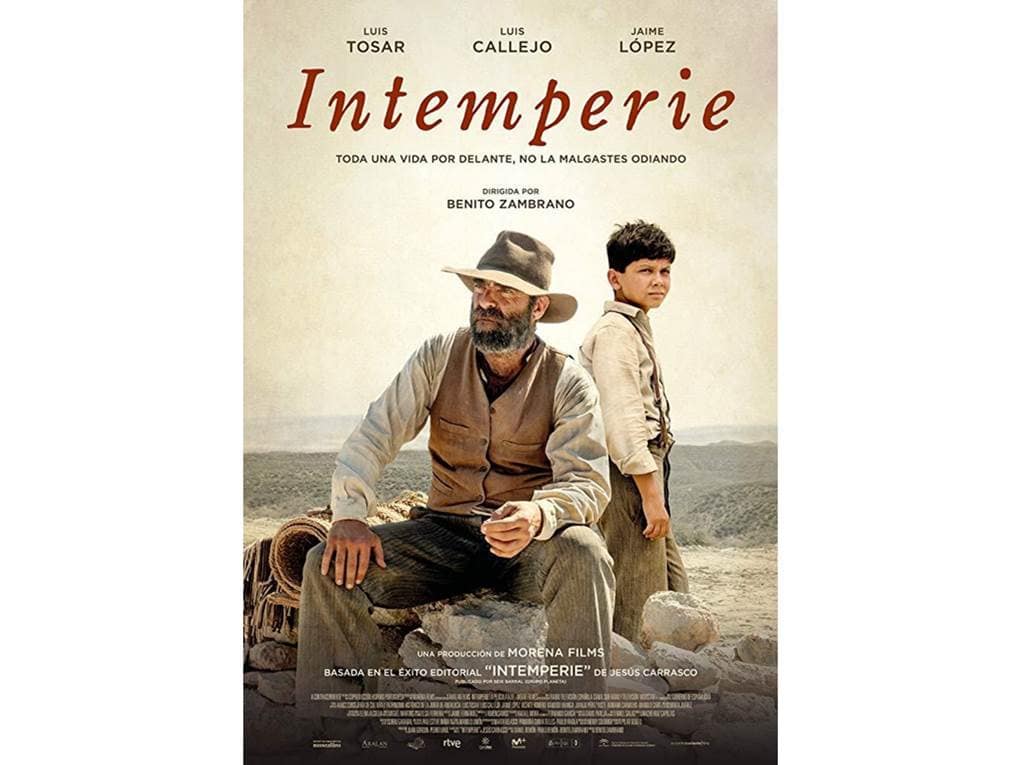
Benito Zambrano’s film, awarded two Goya Awards in 2020 and inspired by Jesús Carrasco’s acclaimed novel, stars Luis Tosar, Luis Callejo, Vicente Romero, and the young Jaime López. “Intemperie” is a moving narrative filled with suspense and emotion.
Set in post-war Spain, the film tells the harrowing escape of a child through a inhospitable region, ruled by violence and plagued by material and moral deprivation. Guided by a reclusive shepherd living on the fringes of society, the child evades the relentless pursuit of his persecutors under the command of the village overseer. The climate and landscape play fundamental roles, almost constituting additional characters. The filmmaker found the perfect setting in the highlands of northern Granada.
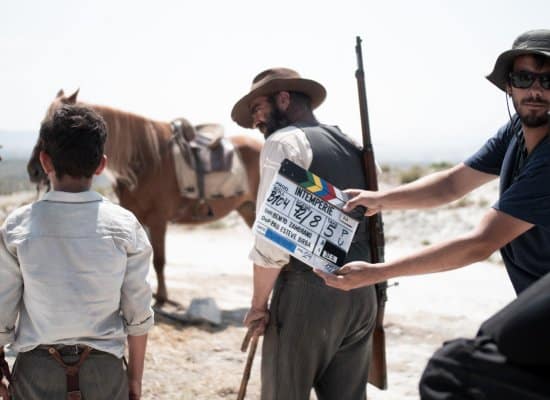
Filmed in the breathtaking landscapes of the Granada plateau during July and August of 2018, taking advantage of the unique and beautiful surroundings of the Geopark of Granada in municipalities such as Orce, Galera, Huéscar, Castril, and La Puebla de Don Fadrique. Iconic locations like Cortijo El Comunal in Galera witnessed the drama as the narrative traversed stunning canyons, imposing badlands, ravines, and rugged valleys.
One of the local residents, Ángel Martínez, assisted the team in bringing authenticity to each frame. As a real shepherd, he trained the actors to navigate the countryside and interact with the animals. Acting as a double for the protagonist in scenes with animals, he even appeared as an extra, alongside two hundred other residents of Orce and Galera.
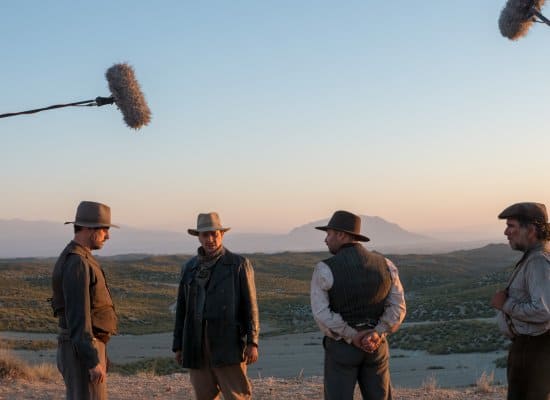
Granada Tourism Office has designed a route inviting exploration of the main filming locations of the movie “Intemperie.” This approximately 76-kilometer route, starting in Orce or Galera, presents no significant technical challenges or elevation changes and can be completed in one or two days by mountain bike or vehicle. While most of the route is accessible with standard vehicles, the section around Galera runs through well-maintained dirt roads, requiring caution in adverse weather conditions. The journey takes you through places like Galera, Cueva de las Yeseras, Cañada del Salar, the archaeological site Venta Micena, Pozo de la Rueda, Orce, Pozo del Comunal, Cortijo de los Llanos, and the archaeological site Castellón Alto. Embark on this cinematic adventure, immersing yourself in the captivating landscapes that served as the backdrop for the enveloping narrative of “Intemperie.” You can find this route on this link.
Secaderos: Exploring Rural Life in the Vega de Granada

“Secaderos” immerses us in a rural story set in the Vega de Granada, where a girl visits her grandparents’ village during the summer, while a local teenager experiences the feeling of being trapped in her own surroundings. The director of the film, Rocío Mesa, originally from Las Gabias, has crafted a magical narrative that explores the intimate relationship between humanity and nature at different stages of life: childhood and adolescence. With images of tobacco drying sheds as a backdrop, the film presents two parallel stories that intertwine during a summer tinged with magical realism. The film premiered at the San Sebastián Film Festival, offering a unique glimpse into rural life in the Vega de Granada, portraying a part of Granada’s history through these intriguing structures. Tobacco was a monoculture in the Vega de Granada throughout the 20th century and ceased for economic reasons.

The shooting of “Secaderos” spanned six weeks, capturing the authenticity of various locations in the Vega de Granada, including Vegas del Genil, Las Gabias, Ambroz, Valderrubio, Fuente Vaqueros, El Jau, La Paz, Chauchina, Churriana, and Purchil. Starring non-professional actors, mostly natives of the Vega de Granada, such as Ada Mar Lupiañez and Vera Centenera, “Secaderos” provides a cinematic experience that explores the connection between humans and the landscape, challenging the traditional perception of rural villages. The film is a choral, multigenerational, and universal tale about the relationship of human beings with their surroundings, addressing both the love for villages and the need to escape from them.
Días Contados (1994): the enduring significance of Alhambra Palace Hotel
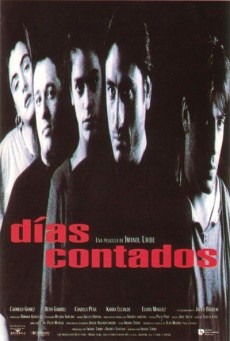
Imanol Uribe immerses us in a captivating narrative based on Juan Madrid’s novel, which garnered eight Goya Awards, the Golden Shell for Best Film, and the Silver Shell for Best Actor (Javier Bardem) at the San Sebastián International Film Festival. Released in 1994, this gripping film delves into complex themes such as ETA terrorism and violence in society.
The movie follows the story of Antonio, an ETA member who, days before committing an attack, encounters Charo, an 18-year-old drug addict. The couple, marked by the storm of their circumstances, lives an intense love story that leads them to Granada. Several key scenes of the film were shot at the Alhambra Palace Hotel, an emblematic and glamorous establishment that has hosted actors of the caliber of Burt Lancaster, Rock Hudson, Lauren Bacall, Orson Welles, Vivien Leigh, Sofia Loren, Steven Spielberg and Brad Pitt.
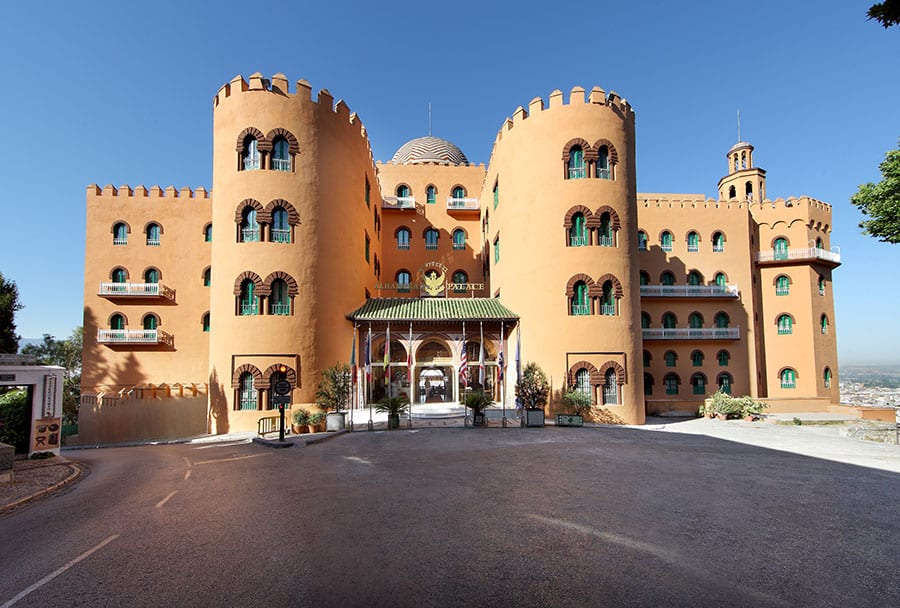
“Días Contados” goes beyond being just a striking thriller; it stands as a distinctive chapter in the cinematic history of Granada. It just another example of the importance of Alhambra Palace Hotel in the history of Granada.
The Hotel Alhambra Palace, built in 1910 under the initiative of Duke San Pedro de Galatino, stands as the oldest five-star hotel in Spain. Designed to cater to the needs of romantic tourism and international visitors, its interior reflects an Alhambresque and baroque style. Interestingly, it served as a space where the architect Torres Balbás conducted preliminary experiments before restoring the Alhambra. In its early years, the hotel housed Granada’s most popular casino.
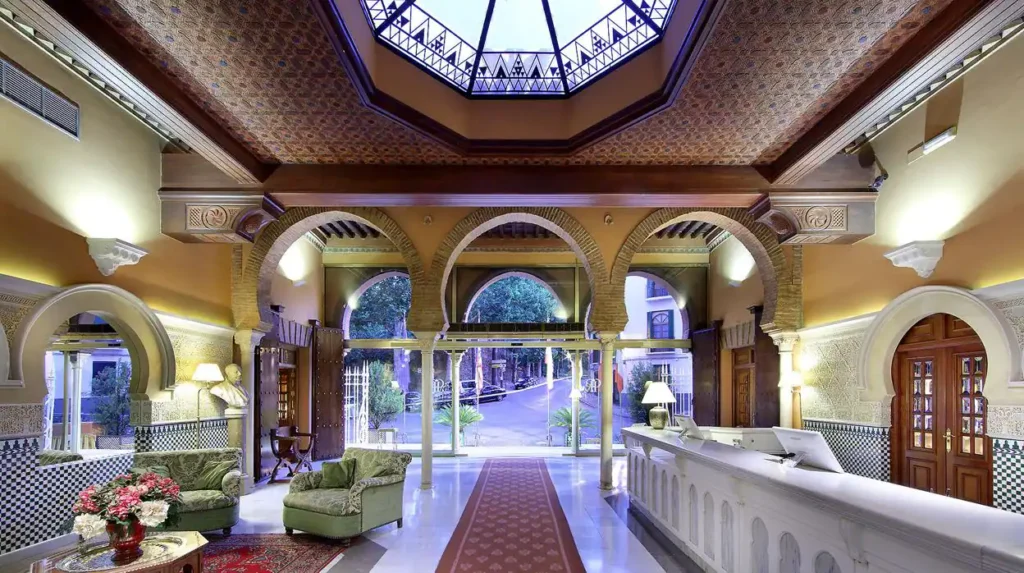
The hotel’s connection to the film industry, particularly Hollywood, has been significant from the outset. During the filming of “El Quijote,” Orson Wells set up his production office in the hotel’s ‘teatrillo.’ This space, integral to Granada’s local and cultural history, now hosts events such as the International Festival of Music and Dance, the International Tango Festival, and various cultural activities.
A notable moment occurred in 1922 with the Concurso del Cante Jondo, presented by figures like Federico García Lorca, Manuel de Falla, and Ángel Barrios in the ‘teatrillo.’ The Hotel Alhambra Palace continues to be a historical and cultural symbol, blending its elegance with events that shape the identity of Granada.
Granada's Enchanting Backdrop: The Cinematic Journey of 'Caníbal' (2013) – A Tale of Love, Morality, and Cannibalism
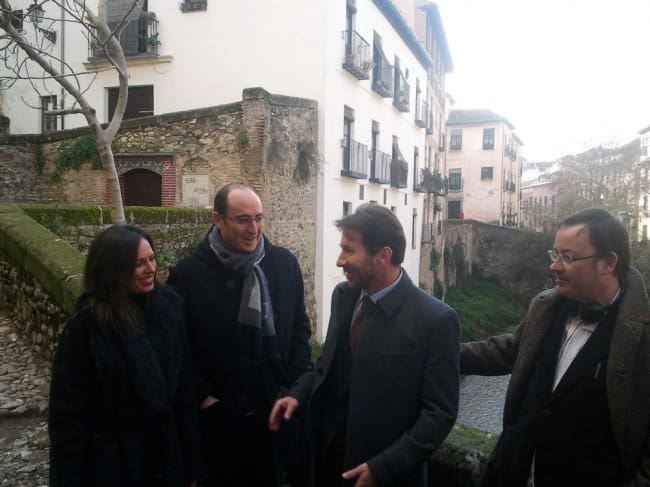
Granada served as the captivating backdrop for the filming of the intriguing thriller “Caníbal” between March and April 2013, directed by Manuel Martín Cuenca and starring Antonio de la Torre, Olimpia Melinte, and Alfonsa Rosso. The city transformed into a unique stage over eight weeks, exploring diverse locations to capture the authentic atmosphere of Granada.
The film unfolds the story of a respected tailor leading a cannibalistic life, murdering women until he falls in love, triggering a moral dilemma.
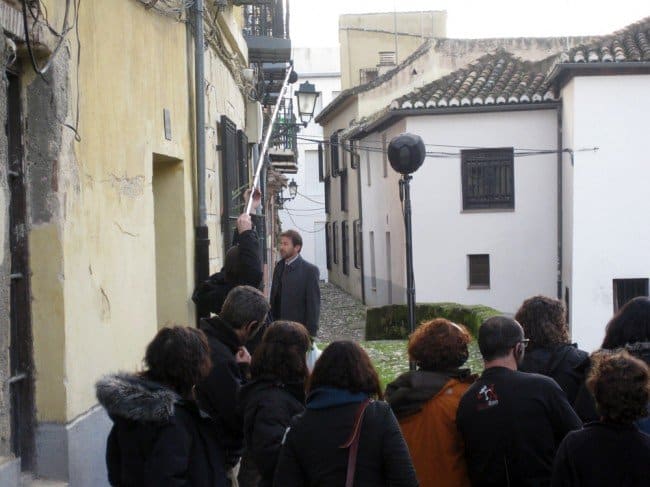
At the heart of the narrative lies the lower Albaicín, specifically in two buildings located on the Carrera del Darro and the Puente Cabrera. One of these buildings housed the protagonist’s tailor shop, while just a few meters away, across the bridge, was the residence, both renovated for the occasion. The capital also saw scenes shot in Plaza Nueva, Paseo del Salón, and Camino de Ronda. Some images were even captured during Semana Santa. The chapel of the parish church of San Pedro and San Pablo makes an appearance in this noir film as the protagonist dresses the Virgin for the nearby Holy Week procession.
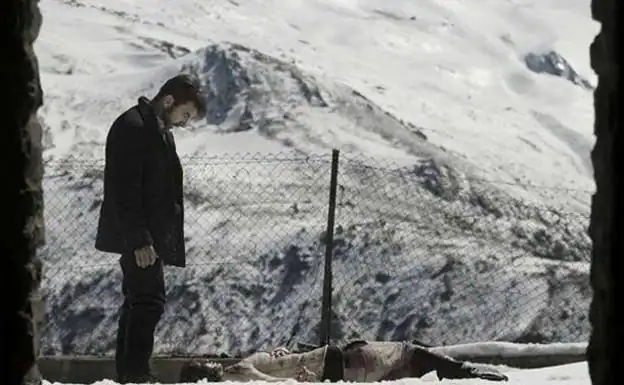
In Sierra Nevada, some of the most impactful scenes of the movie were filmed, leveraging the beauty of the space and the presence of natural snow.
Other locations included a chiringuito (beach bar) on the Costa Tropical, a setting between Motril and Torrenueva, and various places in the province like Carretera de la Cabra, showcasing the uniqueness and variety of Granada’s landscapes.
The director, Almerian Manuel Martín Cuenca, chose Granada due to his unique understanding of the city from his studies and aimed to create profoundly Andalusian cinema, inventing new stories through the rich cultural universe of the region. Arguably, this film best exemplifies the province’s uniqueness and diverse landscapes.
The filming left a significant investment in the city, around two million euros. The team expressed gratitude for the collaboration of the City Council of Granada and the patience of residents amid the minor inconveniences caused by the shoot.
.
A Perfect Day (2015): Hollywood cast brought Balkan War to Granada
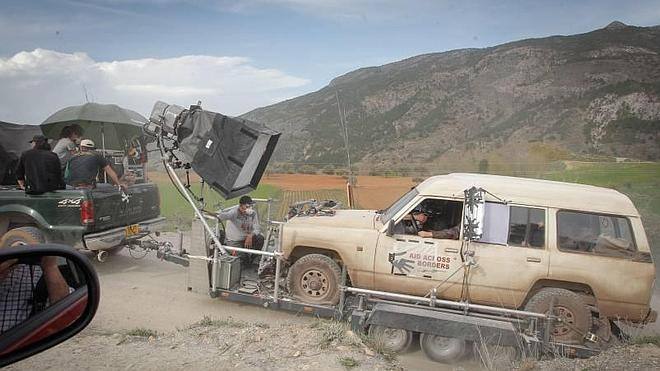
In 2014, Fernando León de Aranoa brought an ambitious project to Granada with a Hollywood cast led by Benicio del Toro and Tim Robbins. The film, titled “A Perfect Day,” is set against the backdrop of the Balkan War, and a significant portion of the shooting took place in various locations across the province of Granada, including the town of Alquife with its abandoned mines, where many extras were local residents.
The movie, known for its dark humor, follows the misadventures of a group of aid workers attempting to extract a corpse from a well in a war-torn area. The filming extended over 50 days in the province of Granada and premiered at the Cannes Film Festival.
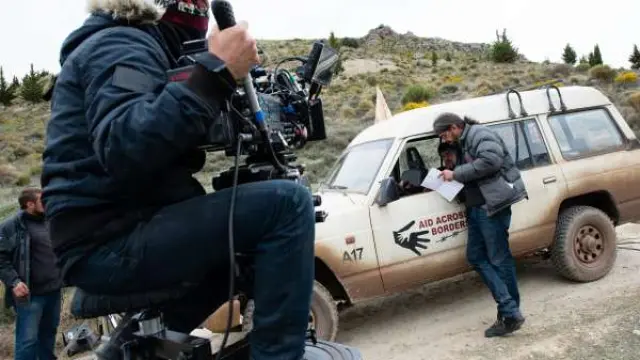
The shooting process, shrouded in secrecy, commenced in the former mining town of Alquife. Subsequently, the cast and crew moved to Monachil, situated on the other side of Sierra Nevada, to continue the shoot. During this phase, a dozen locals selected through a casting process in the municipality joined the production.
The next stop was La Zubia, where various corners of the town served as the imagined Balkan settings envisioned by León de Aranoa. Throughout these weeks, members of the cast, including Robbins and del Toro, were spotted at iconic locations in Granada such as the Alhambra, the Sacromonte, the Albaicín, or attending a concert in support of the Vega de Granada at the Palacio de Congresos.
Cerrar los ojos": A Film Written and Shot on the Costa Tropical
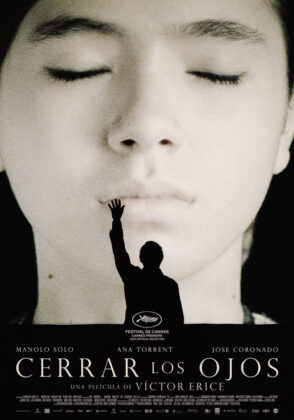
“Cerrar los ojos,” the latest film by acclaimed director Víctor Erice, was filmed over six weeks in the fall of 2022 in various locations in the province of Granada. Starring José Coronado, alongside Manolo Solo and Ana Torrent, the movie unfolds a narrative focused on the themes of identity and memory. The plot, conceived by Erice during his stays in Castell de Ferro (where his wife worked as a teacher), delves into the mysterious circumstances surrounding the disappearance of a renowned Spanish actor, José Coronado, during the filming of a movie directed by his friend, Miguel Garay (Manolo Solo). The actor’s disappearance resurfaces years later under the spotlight of a television program. The film, premiered at the Cannes Film Festival and selected for festivals in Toronto, New York, and London, has received acclaim, winning the Lisbon Film Festival Award and accumulating nominations for 11 Goya Awards, 9 Feroz Awards, and 4 Carmen Awards.
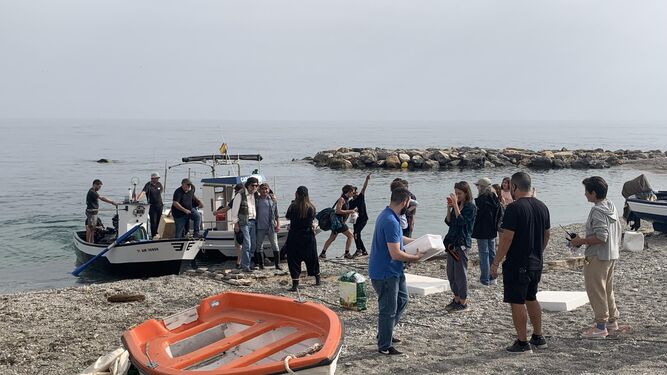
The filming of “Cerrar los ojos” took place between October and November 2022 in various locations in the province of Granada, including the municipalities of Gualchos-Castell de Ferro, Rubite, Nigüelas, and Dúrcal, as well as Almería, Madrid, Alcalá de Henares, Segovia, and Asturias. Highlighting the Granada locations are the Caserones de Rubite beach, the viewpoint and boardwalk of Castell de Ferro, the Plaza de la Constitución in Gualchos, the El Secreto del Olivo Hotel in Nigüelas, and the historic Cinema Lecrín in Dúrcal. Sponsored by the Diputación de Granada through its film and shooting office, Film in Granada, “Cerrar los ojos” seamlessly combines cinematic excellence with the captivating beauty of various Granada locales.
Other movies and dramas filmed in Granada
–”Espagne” by Alice Guy Blaché, the first female director and the first known movie ever shot in Granada in 1905, at Mirador de San Nicolás.
–”Rogues and romance (1920): American silent drama film that is considered the first USA production filmed in Spain. It was filmed in several locations of Andalusia, including Granada.
–Decameron nights (1953): anthology Technicolor film based on three tales from The Decameron by Giovanni Boccaccio which was was filmed in the Alhambra in Granada and Segovia’ s Alcázar.
–Action of the tiger (1956): a British CinemaScope action film, one of the first movies where Sean Connery took part shot. It was shot in Granada, Guadix, La Calahorra, Purullena and Almuñécar to depict Albania.
–It started with a kiss (1959): American romantic comedy film directed by George Marshall and starring Glenn Ford, Debbie Reynolds and Eva Gabor.
–The Colossus of Rhodes (1961): It is the first film with Sergio Leone credited as director. He filmed in Sierra Nevada.
–Lawrence de Arabia (1962): the famous scene where the protagonist and the remnants of the Arab army cross snowy mountains, it was filmed in Sierra Nevada
–For a Few Dollars More (1965): This production was filmed primarily in Almería, Tabernas, Andalucia (Spain), with interiors at Rome’s Cinecittà Studios. The set for the fictitious town of El Paso was built in the Almería desert and still exists as a tourist attraction known as Mini Hollywood. Other scenes were shot in Guadix and the railway station at La Calahorra (Granada). Productions team also built a Western town in La Calahorra on the road to Carches, called Flagstone.
–Once Upon a Time in the West (1968): Filmed in Tabernas (Almería) and La Calahorra (Granada), it begins with a memorable scene that unfolds during the opening credits, with hardly any dialogue, at a train station named Cattle Corner. In reality it is located in the plains of La Calahorra
–Figures in a landscape (1970): Hypothetically, the film is set in some location in South America; however, it was actually filmed in the province of Granada, in the Sierra Nevada.
–Delusions of Grandeur (1971): Gérard Oury filmed scenes in iconic central circular courtyard of Carlos V Palace
–Stardust (1974): The Castillo de La Calahorra was the location used in this famous David Essex film.
–The Wind and the Lion is a 1975 American epic adventure film starring Sean Connery filmed at the castle of La Calahorra and surrounding area.
–”Cuba” is an adventure and action film directed by Richard Lester in 1979, with Sean Connery as the main protagonist. Some scenes were shot in Motril at the Fabrica del Pilar and the vicinity of the Camino del Canal in the Monte Castillo area.
–Clash of the titans (1981)
–”Todo es posible en Granada” (1982): featuring popular Manolo escobar, as the protagonist is a tourist guide and also performs in a cave in Sacromonte, a significant part of the city is featured throughout the entire film.
–Conan the barbarian (1981): this famous Arnold Schwarzenegger movie was filmed in Sierra Nevada, among other Spanish locations.
–”Reds” is a 1981 American epic historical drama film, co-written, produced, and directed by Warren Beatty with scenes shot in Guadix and Granada.
–”Death in Granada” (1997): directed by Marcos Zurinaga, this film is set in the streets of the city center and the surroundings of the Faculty of Law. The story delves into the events surrounding Lorca’s death.
–”Wilde” is a 1997 British biographical romantic drama film about Oscar Wilde directed by Brian Gilbert with Stephen Fry y Jude Law with some scenes shot at courtyard of the Archbishop’s Palace, the Botanical Garden, the Cathedral, Plaza de las Pasiegas and the cemetery of Granada. All these locations represent Italian places in the film.
– “La Luz Prodigiosa” (2003): by Miguel Hermoso, delving into the figure of Lorca and his relationship with the city of Granada. Among the corners of the capital depicted in the film is the well-known Cuesta del Caidero.
–”Isabel” (TV series): In 2013, the city hosted the filming of the successful series ‘Isabel’ to recreate the moment when the Catholic Monarchs take Granada and the Carrera del Darro became the setting for the expulsion of the Jews.
–”El Príncipe”: The successful Telecinco series arrived in Granada in 2015 to film scenes at Carmen de los Mártires, Palacio de los Córdova, and Fundación Rodríguez Acosta.
–”Carlos Rey Emperador” (2015): The sequel to the series ‘Isabel’ – ‘Carlos Rey Emperador’ chose the Cuarto Real de Santo Domingo to film the wedding between Carlos and Isabel of Portugal. Similar to its predecessor, the series also shot some scenes at the Alhambra.
–”Los Farad” (2022 Prime Video TV series), directed by Mariano Barroso and filmed in Marina del Este and Motril.
–”El Tiempo que te doy” (2021 Netflix miniseries): shot in Hotel Salobreña and areas in Granada city like Plaza Bib-Rambla, Alcaicería y the Albaicín.
–”Segundo premio” (2023): Director Isaki Lacuesta has filmed “Segundo premio” in the Realejo neighborhood, in sets like Campo del Príncipe. The film is based on the band Los Planetas and delves into the indie music scene through the songs of the 1990s.
